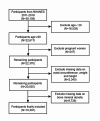Association between a body shape index and bone mineral density in US adults based on NHANES data
- PMID: 39843531
- PMCID: PMC11754829
- DOI: 10.1038/s41598-025-86939-3
Association between a body shape index and bone mineral density in US adults based on NHANES data
Abstract
The relationship between a body shape index (ABSI) and bone mineral density (BMD) remains uncertain, prompting further investigation. This study aims to elucidate the association between ABSI and BMD using data from the 2011-2018 National Health and Nutrition Examination Survey (NHANES), involving participants aged 20-60. ABSI was calculated using the formula: ABSI = 1000 × waist circumference (m)×weight (kg)-2/3×height (m)5/6. The analysis employed weighted multiple linear regression, smooth curve fitting, stratified analysis, and interaction tests to explore the relationship between ABSI and total BMD. The study included 10,291 participants, with a mean age of 39.11 ± 10.77 years, and 49.20% were women. The average ABSI was 80.21 ± 1.50. Total BMD, thoracic spine BMD, lumbar spine BMD, and pelvis BMD were measured, with mean values of 0.82 ± 0.11 g/cm², 1.03 ± 0.15 g/cm², and 1.24 ± 0.16 g/cm2, respectively. A negative correlation between ABSI and total BMD was observed. In the fully adjusted model, individuals in the highest ABSI quartile had total BMD levels 0.045 g/cm² lower than those in the lowest quartile. Interaction tests showed a consistent association between ABSI and total BMD across subgroups, with variations in sex and BMI. This analysis of NHANES data confirms a persistent negative association between ABSI and BMD, suggesting that ABSI could be useful in osteoporosis prevention and diagnosis.
Keywords: A body shape index; Bone mineral density; Cross-sectional study; NHANES; Osteoporosis.
© 2025. The Author(s).
Conflict of interest statement
Declarations. Competing interests: The authors declare no competing interests. Ethical statement: The studies involving human participants were reviewed and approved by the NCHS Ethics Review Board. The patients/participants provided their written informed consent to participate in this study. Consent for publication: Not applicable.
Figures



References
-
- Melaku, Y. A., Gill, T. K., Adams, R. & Shi, Z. Association between dietary patterns and low bone mineral density among adults aged 50 years and above: findings from the North West Adelaide Health Study (NWAHS). Br. J. Nutr.116, 1437–1446 (2016). - PubMed
-
- Burger, H. et al. Risk factors for increased bone loss in an elderly population: the Rotterdam Study. Am. J. Epidemiol.147, 871–879 (1998). - PubMed
MeSH terms
LinkOut - more resources
Full Text Sources
Medical

